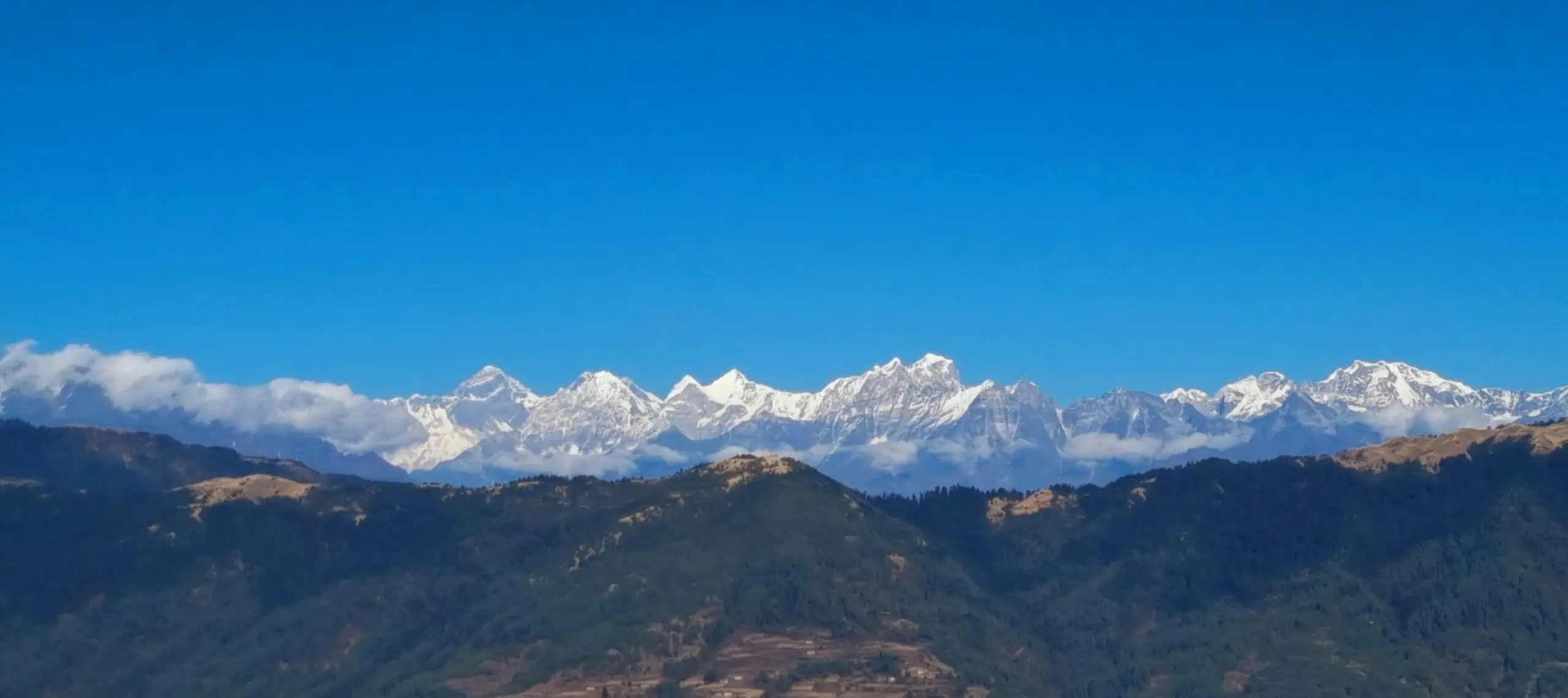
Tilicho Lake and Annapurna Circuit Trek - 15 Days 15 Days
USD 1,250
USD 1,099 per person
| Activities | - | Fitness Level | Moderate |
| Max Elevation | 5416m | Commute | Kathmandu to Pokhara |
| Best Month | Autumn,Spring,winter | Group Size | Min: 2, Max: 10+,single |
| Arrival on | Kathmandu | Depart From | Kathmandu |
| Meal | B L D | Duration | 15 Days |
| Stay | Hotel & Tea House | Price | USD 1,099 per person |
Tilicho Lake and Annapurna Circuit Trek is the classic, most diverse and stunning trek in the Himalayas witnessing the fascinating ethnic groups and incredible scenario of mountains, crystalline Tilicho Lake and the zenith of Annapurna massif- Thorang-la Pass.
The trek highlights exceedingly beautiful valleys like Marshayngdi & Kali Gandaki. The cultural encounters in numerous ethnically inhabited villages are the wonders of Nepal’s cultural diversity seen during the trek. The floral and faunal biodiversity of Annapurna Conservation Area Project are great sights. The rawness of nature that include pure cascading waterfalls, Rocky Mountains and deep gorges are mesmerizing. The most important climaxes of the trek is the Himalayan vista from the top of Thorung La Pass. Similarly, the most exciting scene appears when you reach at the beautiful- Tilicho Lake. This Tilicho Lake is one of the heighest altitude lake in the world laying at an altitude 4949m above the sea level. The incredibly adventurous walk to the top of Thorung- La Pass and down to Muktinath is beautifully challenging. The shifting views of Annapurna and its neighboring peaks are always the prime highlights of Annapurna Circuit Trek. Last but not the least Jomsom the last stopover point of the trek is simply an icing on the cake. In addition, if you wish to enjoy natural beauties, enhance cultural experiences of Annapurna Region, you could join our Round Annapurna Trek-19 Days. Meantime, the best alternative of this trek is Manang Valley and Annapurna Circuit Trek-15 Days. If you are not satisfied with this itinerary or if you want to customize this package in your timeline or budget, then you could contact us, or email to [email protected]
Outline Itinerary:
Day 01: Arrival day in Kathmandu transfer to Hotel (1350/4428 ft) (Meal: Dinner) Day 02: Drive to Besisahar 6-7 hrs (760 m/ 2510 ft) bus (Meal: BLD)
Day 03: Jeep drive to Chame (2670 m/8810 ft)Drive: 7/8 hrs. (Meal: BLD)
Day 04: Trek from Chame to Pisang (3200 m/10524 ft) Trek: 5- 6 hours (Meal: BLD)
Day 05: Trek from Pisang to Manang, (3400 m/11152 ft) Trek: 5 to 6 hrs. (Meal: BLD)
Day 06: Rest day at Manang for acclimatization (3400 m/11152 ft) (Meal: BLD) Day 07: Short Trek from Manang to Khansar Village (3734 m/12322 ft) Treks 2 to 3 hrs. (Meal: BLD)
Day 08: Excursion to Tilicho Lake, back to Tilicho Base Camp/Khangsar village ( 5200m/17056ft) Trek: 6 to 7 hrs. (Meal: BLD)
Day 09: Trek from Khansar Village to Yak Kharka ( 4010m/13153ft), Trek: 4-5 hrs. (Meal: BLD)
Day 10: Trek from Yak Kharka to Thorong Phedi (4,600m/15,092ft. Trek: 5-6 hrs. (Meal: BLD)
Day 11: Trek to Muktinath (3,800m, 12464ft) via Thorung La pass (5,416m, 17332ft) Trek: 7-8 hrs. (Meal: BLD)
Day 12: Trek from Muktinath to Jomsom (2720 m/ 8976 ft) Trek: 5-6 hrs. (Meal: BLD)
Day 13: Fly to Pokhara, transfer to Hotel ( 820 m/2705 ft) Flight: 20 minutes.
Day 14: Drive to Kathmandu (1350/4428 ft) (Meal: B/D)
Day 15: Departure from Kathmandu (1350/4428 ft) (Meal: Breakfast)
Costs
What is included
🟢Airport transfer by Hiking Nepal office representative in a private vehicle
🟢Farewell Dinner at finest restaurant in Thamel Kathmandu
🟢Kathmandu to Besisahar transfer in a sharing vehicle- upgrade to private vehicle is also available
🟢Besisahar to Chame drive in a sharing vehicle
🟢2 Nights’ accommodation at Tourist Standard 3 Star Hotel in Kathmandu with breakfast on twin sharing basis
🟢11 Nights’ accommodation at well and comfortable Mountain Lodge available en-route during trek (Few nights’ at during trek with attached bathroom/toilets)
🟢1 Night accommodation at 3 star Hotel in Pokhara with breakfast on twin sharing basis
🟢Full Board Meal during trek (Breakfast, Lunch, Dinner, tea & coffee, seasonal fruits, chocolate/s & biscuits)
🟢English speaking, First Aid and Eco-trained local trekking guide, Assistance guide as per the group size, porters (2:1), all the expenses for guide and porters along with Insurance
🟢Domestic Airfare and Tax for the sector Jomsom/Pokhara
🟢Pokhara to Kathmandu transfer in a Tourist Bus- Option for private vehicle or flight is available
🟢Annapurna Conservation Area Project (ACAP) fee
🟢Trekkers Information Management System (TIMS) card fees
🟢Exclusive medical kit bag, Duffle Bag, Trekking T-shirt, Adventure Certificate
🟢Sleeping Bag and Down Jacket during Trek if required
🟢All Government and local taxes as applicable
What is not included
🔴Nepal Visa - (Cost- US$- 30 for 15 Days & $- 50 for 30 Days)
🔴Lunch & evening meals while in Kathmandu and Pokhara (Except welcome/farewell dinner)
🔴Travel Insurance
🔴Cost of personal nature expenses, Beverages (Mineral water or coca cola), cost of extra meals, snacks, phones bills, Internet, WiFi, laundry etc.
🔴Cost incurred during emergency, evacuations
🔴Tips for Guide/porters/driver
🔴 Anything other than not mentioned in “Service Includes”
Map

Altitude Chart

DETAILED ITINERARY
Day 1: Arrive Kathmandu International Airport, transfer to Hotel (Altitude: 1350/4428 ft. Meal: Dinner)-
On your arrival in Kathmandu International Airport, one of our office representative will pick up you and escort you to the hotel as well as help you to check-in at hotel. After refreshment, you will be briefed about the next day trip. In the evening, we, the Hiking Nepal, will offer you a welcome dinner introducing Nepalese cuisine and culture.
Day 2: Drive to Besisahar (Altitude: 760 m/ 2510 ft. Drive: 8-9 hrs. – bus/ 6 hrs. – Jeep Meal: BLD)-
After having breakfast, our guide will meet you at hotel to drive to Besisahar. Recheck your luggage and be ready for a drive. Following River Marshyangdi, you will reach at Besisahar. On the way, you can explore the Green Mountain, scattered village and refreshing landscape. Stay overnight at local lodge.
Day 3: Jeep drive to Chame (Stopover for acclimatization) (Altitude: 2670 m/8810 ft. Drive: 7/8 hrs. - local bus Meal: BLD)-
From Besisahar, catching a local bus, you will starts to drive in a bumpy road towards Chame. It is a small village of the Annapurna Region at an elevation of 1430 m. You can enjoy waterfall that attracts both the local and tourists. Stay overnight at local lodge.
Day 4: Trek Chame to Pisang (Altitude: 3200 m/10524 ft. Trek: 5- 6 hours Me-
Today, you will have a steep walk through dense forest into a narrowed valley. Crossing the raging Himalayan River at two points 2,910m & 3,040m are absolute highlights of the trek. Just crossing a suspension bridge at 3040m, the stunning view of Rocky Hill Paungda Danda feasts catch by the eyes. Beyond here, the course connects towards Pisang on a steep trail. Pisang, nestles between 3,200m and 3,300meters. Stay overnight at local lodge.
Day 5: Trek Pisang to Manang, Overnight at local lodge (Altitude: 3400 m/11152 ft. Trek: 5 to 6 hrs. Meal: BLD)-
After breakfast, you will walk through the arid & higher region of Manang. As you trek higher, the region affected being at the rain shadow of Annapurna comes into sight. Natives of this county flock yaks most of the times of the year and cultivate crops for a very short period of the year. As you leave Pisang, you will tread along the northern via Ghyaru for the better views of the Himalayan peaks throughout the trail that chases along the northern bank of the river. Now, you will arrive to Munchi. Beyond Munchi, the trail passes the charming and the authentic village of Braga 3475m. The last push brings to Manang.
Day 6: Rest day at Manang for acclimatization (Altitude: 3400 m/11152 ft. Meal: BLD)-
Starts a day with morning tea and explore the surrounding. Today, you will take a rest day. Hence, it is your time to use as you like. You can hike for a while to get familiarize with altitude. You can go nearby Gangapurna glacier or visit the Manang village, Gompas and cave exploring native people and culture. Spend overnight at Lodge.
Day 7: Short Trek to Khansar Village (Altitude: 3734 m/12322 ft. Treks: 2 to 3 hrs. Meal: BLD)-
Today, you will have a short climbing up to the Khangsar village. The trail cuts down through a gorge; you can click the picturesque view of Tilicho Peak along with the beautiful Annapurna range. On the way, you will cross a small settlements and monastery and pass along the Khangsar river and a wall taking you to Khangsar. Stay overnight at local lodge.
Day 8: Excursion to Tilicho Lake, back to Tilicho Base Camp/Khangsar village (Altitude: 5200m/17056ft, Trek: 6 to 7 hrs. Meal: BLD)-
One of the highlight of this trek is your visit to Tilicho Lake, a beautiful lake at an altitude 4920 m forming highest lake in the world. Today, you will starts trek through a grassy field and slightly climb up to a hill from where you can view the entire valley. Then, slowly slopping down in a steep inclination, you will reach at Tilicho Base Camp. Resting for a while, walk in steep uphill onto a moraine, along the side of the mountain. You will never miss to grasp the closest views of spectacular peaks- Tilicho, Nilgiri, Khangsar as well as Muktinath Peak. Reaching Tilicho Lake, you will get eyepopping view of tranquil lake and surrounding. Enjoy the surrounding for a while, then make your journey to Tilicho Base Camp.
Day 9: Trek Khansar Village to Yak Kharka (Altitude: 4010m/13153ft, Trek: 4-5 hrs. Meal: BLD)-
While returning from the Tilicho Base Camp, you will follow the trail to the alpine vegetation. Walk along the ruins of the old Khangsar village, you will cross a wooden suspension bridge leading you towards the Yak Kharka. It is a place where Yaks are left for grazing. From here, you can have outstanding views of Annapurna III. Stay overnight at local lodge.
Day 10: Trek Yak Kharka to Thorong Phedi (Altitude: 4,450 m/ 14685 ft. Trek: 5-6 hrs. Meal: BLD)-
Today, you will walk uphill to the Thorang Phedi. Walking for a while in an easy trail, you will sross a suspension bridge leading you towards Ledar village. Then, slightly ascend and passing through towering cliffs, you will reach at Thorang Phedi. It is the last village before Thorang-la Pass. During the trail, you can click the views of Mt. Gundang, Thorang Peak, Mt. Syangang and Mt. Khatungkan. Overnight in Thorang Phedi.
Day 11: Trek to Muktinath via Thorung La pass - 8 hrs (Altitude: Thorung-la Pass: 5416 m/ 17873 ft. Muktinath: 3800 m/12540 ft. Trek: 7-8 hrs. Meal: BLD)-
Here comes most exciting and adventurous time as you are going to cross the world’s largest pass- The Thorong-la pass. Hence, today’s trek will be lengthy, you will start trek early. Five hours of steep strenuous walk from the camp at Thorung Phedi brings you to the top of Thorung La Pass 5416m. The regular course to Thorung La Pass seems easy. However, a number of difficulties might encounter due to the elevation and snow. Getting up to the pass may be tough but the acme of the pass marked by revered chortens and colorful prayer flags will reward you with the most eye-catching views of Himalayas that include Annapurna at its best.
Day 12: Trek Muktinath to Jomsom (Altitude: 2720 m/ 8976 ft. Trek: 5-6 hrs. Meal: BLD)-
You will descent through the Kali Gandaki Valley to Jomsom, the windy city & the home to the apple orchard of Nepal. Coming down hill, you always have to be cautious and not be excited to reach the destination. Spend overnight at local lodge.
Day 13: Fly to Pokhara, transfer to Hotel (Altitude: 820 m/2705 ft. Flight: 20 minutes)-
From the windy city Jomsom and you will take a flight back to Pokhara. Leaving the tranquil isolation, as you land at Pokhara, you will be once again transferred to your hotel in the city. Rest of the evening at your own.
Day 14: Drive to Kathmandu (Altitude: 1350/4428 ft. Drive: 5-6 hrs. Meal: B/D)-
While driving back to Kathmandu the 1st half of the trip is along the highway above Seti and Marsyandi Rivers and the latter half winds along Trisuli River. Green hills along the spiral roads, stopping in between for snacks (fish) are the trip highlights. Upon arriving at Kathmandu, you will be transferred to the hotel in the city. Take your time for refreshment. Evening, we, Hiking Nepal team, invite you for a dinner. Give us chance to make your evening a wonderful time.
Day 15: Depart Kathmandu (Altitude: 1350/4428 ft. Meal: B)-
Our tour officer will pick you up from your hotel three hours prior to your departure time. You will be escorted in a private vehicle to the airport for your final departure. Have a safe flight home
DEPARTURE DATES
| START DATE | END DATE | STATUS | PRICES |
|---|---|---|---|
| 5th Nov | 20th Nov | Limited Seats |
$ 1,099
|
| 9th Nov | 24th Nov | Limited Seats |
$ 1,099
|
| 12th Nov | 27th Nov | Limited Seats |
$ 1,099
|
| 16th Nov | 1st Dec | Limited Seats |
$ 1,099
|
| 20th Nov | 5th Dec | Limited Seats |
$ 1,099
|
| 25th Nov | 10th Dec | Limited Seats |
$ 1,099
|
| 30th Nov | 15th Dec | Limited Seats |
$ 1,099
|
FAQ
No FAQs available for this tour.
REVIEWS
RELATED TRIPS

Sunder Peak Trek
Sunder Peak, a short trekking in the Everest Region follows the traditionally and historically impor...
More Details
Pikey Peak Trek
Pikey Trek- short and outstanding trekking to the Himalayas viewing the stunning Himalayas including...
More Details
| 1 person | 2-7 person | 8+ person |
|---|---|---|
|
$ 1,099
Partial Pay
|
$
999
/ per
Partial Pay
|
$
950
/ per
Partial Pay
|




- Speak to one of our travel consultants
- Call Us (24/7) : +977 9802342080
-
 WhatsApp (24/7) : +977-9802342080
WhatsApp (24/7) : +977-9802342080
Planning a Trip?
We have a pool of travel experts working in this industry for more than a decade. Consult to get started
BOOK A CALL